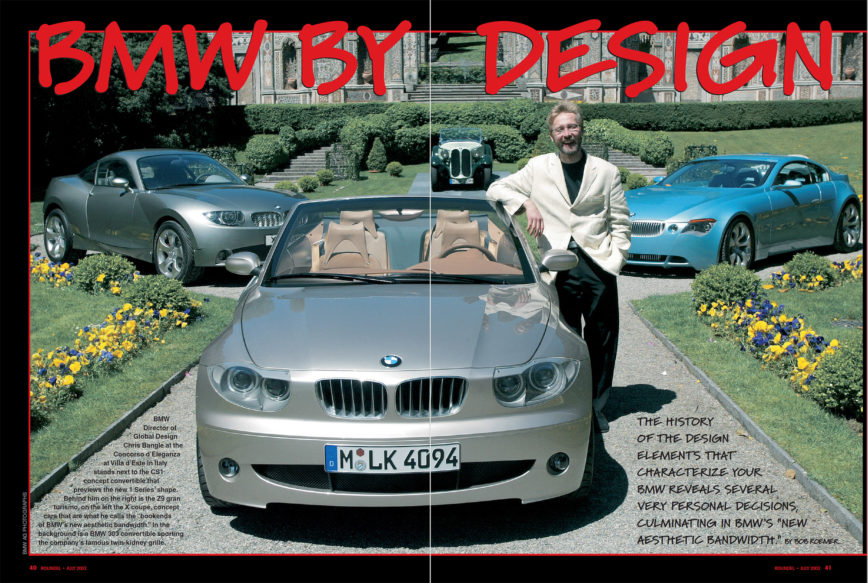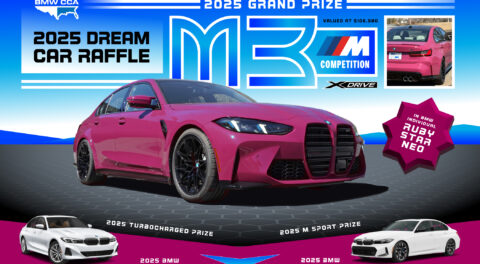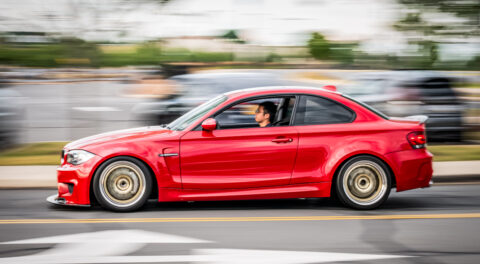[Twenty years ago, BMW CCA’s Roundel magazine featured a story about how BMW design changes challenged conventional ideas of what made a BMW. Reprinted from the July 2002 BMW CCA Roundel magazine, all rights reserved. Photos provided for article by BMW AG.]
BMW CCA members get access to over 20 years of Roundel Magazine online! Learn more and join today at BMW CCA.
BMW By Design
The history of the design elements that characterize your BMW reveals several very personal decisions, culminating in BMW’s “new aesthetic bandwidth.”
By Bob Roemer
BMW Director of Global Design Chris Bangle at the Concorso d’Eleganza at Villa d’Este in Italy stands next to the CS1 concept convertible that previews the new 1 Series’ shape. Behind him on the right is the Z9 gran turismo, on the left the X coupé, concept cars that are what he calls the “bookends of BMW’s new aesthetic bandwidth.” In the background is a BMW 303 convertible sporting the company’s famous twin-kidney grille.

BMW Design still used clay models in the early 2000s.
As he often did, Michael Schimpke was lecturing a group of journalists; the subject, on a beautiful early morning in Malaga, Spain, was the distinctive BMW look. Using one of the several then-new E36 3 Series coupes we were there to test drive as his classroom chalkboard, the Munich public relations manager-turned-professor was in rare form.
“Now pay attention,” he said, his grin betraying his attempt to play the stern educator. “The traditional elements of BMW design are four round headlamps, the twin kidney grille, the Sicke, and what we call the ‘Hofmeister-Knick.’” As he spoke, Schimpke made dramatic gestures, drawing each feature in the air with his fingers and then pointing to it on the car.
“Any questions?” he asked. When we replied in the negative, he nodded and said, “Very well then, there will be a quiz at lunch.” A bonus question for that quiz could be, “How many of these design elements originated in BMW’s design studios?” The answer might surprise you.

BMW’s trademark twin-kidney grille, shown here on a late-1930s 327 coupe, was adopted in 1932. It first appeared on aftermarket custom bodies made for the BMW Dixi by Ihle in Karlsruhe.
Transplanted Kidneys
The most famous BMW design element is, without question, the twin-kidney grille. The kidneys made their debut on BMW’s first car, the Dixi, in 1927—but not as the fifteen-horsepower flivvers left the company’s factory in Eisenach. Some owners had their Dixis retrofitted with an aftermarket custom body designed and built by Ihle in Karlsruhe. That special bodywork transformed the tiny car from a rather plain-looking runabout into a dashing sports car featuring a unique radiator grille in the shape of two elongated ovals: Almost immediately, they were dubbed “the kidneys.”
At the 1933 Geneva auto show, BMW officially introduced the kidney grille on the new 303, powered by the company’s first six-cylinder engine, a 30-horsepower, 1.2-liter unit. Ironically, given the company’s current reputation for building the best inline sixes in the world, it is the smallest engine of its kind in automotive history. Engineer Fritz Fiedler, poached from Horch, designed the car’s tubular chassis and its body. In an effort to reduce aerodynamic drag, he drew the radiator grille with a slight slope to the rear and rounded corners, resulting in the now-famous shape.
Intrinsic as they are to its image, the kidneys nearly became a casualty of BMW’s financial near-death experience in 1959. German industrialist Herbert Quandt snatched the bankrupt company from the jaws of Daimler-Benz in an eleventh-hour rescue because he had faith in a recovery plan based in large part on a new middle-range car.
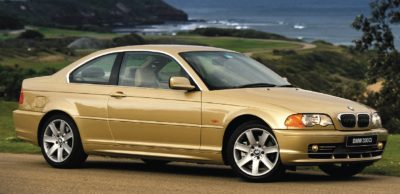
The E46 330Ci displays BMW’s traditional design elements: twin-kidney grille, four round headlights, the Sicke feature line below the greenhouse, and the Hofmeisterknick bend in its C-pillar.
Not having the luxury of time, BMW recruited Robert Pertuss from car-body manufacturer Karmann to be a member of the company’s board, and to kick the development of what was to become the 1500 into high gear. Because of his background—he directed the creation of Volkswagen’s Karmann Ghia—Pertuss first focused his attention on the car’s body. He ordered a redesign of its face, junking the twin kidneys in favor of a conventional wide, horizontal grille. In one of the few times he injected his opinion into product decisions, Quandt, who loved cars, overruled Pertuss, reasoning that the unique grille was the company’s icon. Had he been more in the mold of a typical financier who had neither the time nor interest to consider frivolous things like a symbol, the twin kidney grille might not have survived.
Bavarian Kink
The next element of the BMW Look made its debut when the company introduced the elegant 3200 CS coupe and the “New Class” 1500 sedan at the 1961 Frankfurt auto show. Both cars—the Bertone studio designed the coupe and Giovanni Michelotti drew the original concept for the sedan—featured a distinctive bend in their C-pillars, the metal roof supports that separate the rear side windows from the back glass. This bend, seen on almost every BMW built since then with the exception of convertibles, the Isetta, the 600, the 700, some touring models, and the Z3 coupe, became known as the Hofmeister-Knick, or Hofmeister Kink, named after Wilhelm Hofmeister, director of the design department at the time. It is also called the Hofmeistereck, meaning Hofmeister Corner.
It’s difficult to say who originated the kink; it appeared on some coupes from various manufacturers in the 1930s, and there are sketches in the BMW Design archives done in the mid-1950s, one of a two-door sedan that would eventually become the 2002 and the other of a never-built 2+2 coupe, both with kinked C-pillars. “There are also many sketches in our archives of concepts without a C-pillar kink,” says David Carp of BMW Design. “Its popularity has something to do with its success as a compositional tool. When you’ve absorbed the car’s overall proportions, you read the greenhouse [the car’s glass area], and this line helps anchor it to the body by guiding your eye safely toward the rear wheel and back to the space within the wheelbase. The result is a dynamic, yet stable relationship of the greenhouse and body masses.”

BMW designers work at the research and innovation center in Munich and at Designworks/USA in Newbury Park, California. Here Chris Bangle, second from right, and a team of designers examine a work-in-progress in the Munich studios.
The kink also subtly emphasizes a BMW engineering trademark: rear-wheel drive. “There have been BMWs in the last 40 years without it, and we have never seen it as unassailable,” says Carp, “but as it’s been used on both sedans and coupes, it’s quite good. In any case, whether Herr Hofmeister requested the feature from his Italian consultants or whether the proposal originated with them, it was he who recognized its value to BMW design and made it an institution.”
What’s a Sicke?
Some words simply don’t translate well from one language to another, and Sicke is one of them. In technical terms it is the stamped crease in the sheet metal you see along the flanks of most contemporary BMWs, but using a technical definition to describe a design feature doesn’t do it justice. About the closest English equivalent you’ll find is “feature line,” but Munich designers will tell you that doesn’t completely capture its essence, either.
Not only is it difficult to translate, pinpointing its origin is also tricky. Postwar 502 “Baroque Angel” sedans and convertibles designed by Peter Szimanowski featured a thin chrome strip running from the hood to the trunk’s shut line. Goertz’s 507 was the first to use unadorned stamped lines trailing aft from each wheel arch. The “New Class” 1500 through 2002 models had a crease, some with a chrome strip and some without, on their doors and rear fenders to visually connect the hood and trunk shut lines. A thin feature line can be seen on Bertone’s 3200CS. The first model to use the Sicke as it is known today was the E3 2500 sedan, designed by in-house stylists with input from Giovanni Michelotti, introduced in 1968.
Four Eyes
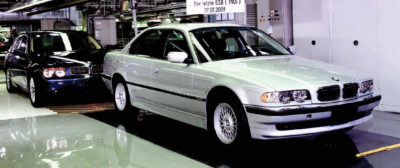
Chris Bangle’s concept of stretching the boundaries of what he calls the “look: BMW” is illustrated by comparing two cars: the last E39 7 Series leaving the Dingolfing assembly line, followed by the first example of its E65 replacement.
The final design element, four round headlamps, is the most recent, more a product of evolution than conscious decision. As the 3 Series and 5 Series replaced their “New Class” predecessors, Munich used the number of headlights as a rank insignia indicating the position of models within the Series’ hierarchy. For example, E21 315s, 316s, and 318s had to get by with two lights, while the series-topping 320i announced its status with quad lamps. When BMW introduced the six-cylinder 320i and 323i, they, too, sported four headlights. A popular aftermarket item in Germany for owners of “lesser” Threes and Fives was a four-headlight conversion kit; removing or upgrading their car’s trunk-lid model designation completed the ruse.
Even though they were not always top-of- the-line models compared to what was available in Europe, all 3 Series and 5 Series cars sent to the U.S. were equipped with four headlights. By the late 1980s, the four-headlamp look was the norm for most BMWs; however, cars with concealed lights—the M1 and the 8 Series—were notable exceptions. The Z1 roadster featured rectangular lights because of its steeply sloped nose. Some European models of the E28 5 Series had the tops of their round headlights shaved off, strictly as a design feature.
Revolution in the Evolution
Beginning in the 1960s, BMW fell into a rhythm for design progression, sometimes by design and sometimes by chance, alternating major changes with evolutionary updates. The 3 Series is a good example; the E21 320i, introduced in 1975, represented significant change from the venerable ’02 models it replaced. The E30 3 Series, first seen in 1982, was an evolution of the 3 Series concept. Eight years later, the E36 3 Series gave traditionalists quite a shock with its completely new shape inside and out. In 1998, BMW unveiled the current E46 3 Series, a slightly larger and more sophisticated version of its predecessor.

The Z9 gran turismo, introduced in 1999, establishes a new design direction for future 5, 6, and 7 Series cars.
Then, in 1992, Chris Bangle came to Munich. Fresh from Fiat, where he had captured the attention of auto executives and enthusiasts alike with exciting shapes like the Fiat Barchetta, the Wisconsin native assumed command of BMW Design just as a styling renaissance began to sweep an industry eager to put the aerodynamic fad of the 1980s that produced look-alike jellybean- shaped cars in its rear-view mirror. Bangle’s passion for automobiles—and his appreciation for how even the smallest of details can delight a driver—are reflected in the 3 Series coupe, the X5, and the Z8. But his vision of making BMW a leader in design as well as technology requires much bolder shapes; it requires, in his words, a “new aesthetic bandwidth.” Translating one of the best examples of corporate “Dilbert-speak” we’ve heard lately, that means Bangle is broadening established design parameters to present a much more diverse look for BMWs in their various model series while still honoring traditional design elements. “We call this the ‘Revolution in the Evolution,’” he says. “The nature of BMW design is evolutionary, but many people do not realize how much innovation is expected in the phases where the ‘look: BMW’ jumps to the next higher evolutionary tier. It is for them truly ‘revolutionary,’ even though in the strictest sense it adheres to the parameters of the evolutionary progression.”
If nothing else, Bangle is a consummate salesman. He convinced the hard-nosed, data driven German engineers on BMW’s board that the company—doing rather well, thank you, with its traditional designs—should dramatically change the look of its products. Many of the concepts emerging now were conceived in a six-month creative brainstorming workshop in 1996—called “Deep Blue”—conducted to redefine BMW design. Just how much bandwidth Bangle and his design associates need is best illustrated by two recent concept cars, the X coupé and the Z9 gran turismo. Unlike many manufacturers that create concept cars just for the “wow factor” at auto shows, Bangle used the pair to delineate the boundaries of a new playing field—or, as he says, “bookends.”
Exhibiting the new BMW design pillars of proportion, surface, and details, the X coupé establishes a direction for 1, 3, and Z Series cars, while the Z9 sets the tone for larger, more luxurious BMWs. Bangle is also a man of his word. The Z9’s dashboard and iDrive system feature prominently in the new 7 Series sedans, and he freely admits that if you imagine the CS1 concept convertible, introduced at this year’s Geneva auto show, with a steel roof, you’re looking at the 1 Series, complete with “flame-surfacing” concave and convex curves as first seen on the X coupé. Insiders say that the upcoming 6 Series coupe and convertible feature Z9-like noses.
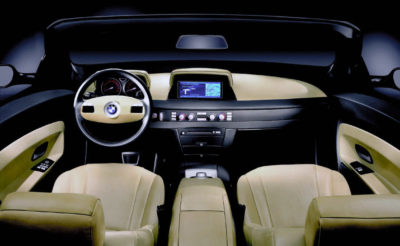
Not just for show: Bangle uses concept cars to preview features and shapes to be used on future models. The dashboard and iDrive system featured in this Z9 convertible are now standard features in the new 7 Series sedans.
As BMW enthusiasts are aware, this is not a bloodless revolution. Bangle’s designs, often described as “polarizing,” have created a firestorm of controversy. Veteran auto journalist Paul Lienert, writing about the new 7 Series for The Detroit News, observes, “There’s a whole new face that’s been drawn around the hallmark BMW twin kidney grilles, so the latest car still bears a slight family resemblance to the rest of stable, even though its scalloped headlamps look much more fresh and contemporary. There’s an even more pronounced departure in the rear, where the styling looks like it might have come from one of the major Japanese studios. The big wraparound tail lamps, for instance, could have been lifted directly from the Acura RL sedan. Critics don’t much seem to care for the taller-than-usual deck, which they claim gives the car an awkward, tail-heavy look.” Several designers from other carmakers, who typically keep negative comments about their colleagues’ work to themselves, publicly criticized the new Seven when they saw the flagship sedan for the first time at last year’s Frankfurt auto show, and it was almost impossible to find someone outside BMW who had a positive comment about the X coupé at the 2001 Detroit show.
Nearly half of the 4,400 respondents to a Roadfly.com on-line poll said they do not like Bangle’s designs. There was even an on-line petition calling for his ouster. Bangle, of course, is aware of the negative reaction, but is convinced he’s on the right course. “The new Seven was the most challenging type of project any design team can take on: Interpret the top image-driving product of a successful brand into the next millennium, and do it in a manner that could be the starting point for a whole new generation of diverse but equally successful products,” he says. “Never in the history of the company did we research, study, or explore more alternatives than in the making of this car. But when we reflected, processed, and compared what we had learned, the choice for the final design was quite clear. The team performed brilliantly, and the result is far more than the output of a single designer or a single design, it is the real embodiment of what BMW design is: bold, consequential, strategically driven, and customer focused—but more than anything, dedicated to the unique personality that is this great marque.”
Note: Special thanks to David Carp and Jochen Frey of BMW for their assistance in the preparation of this article.

